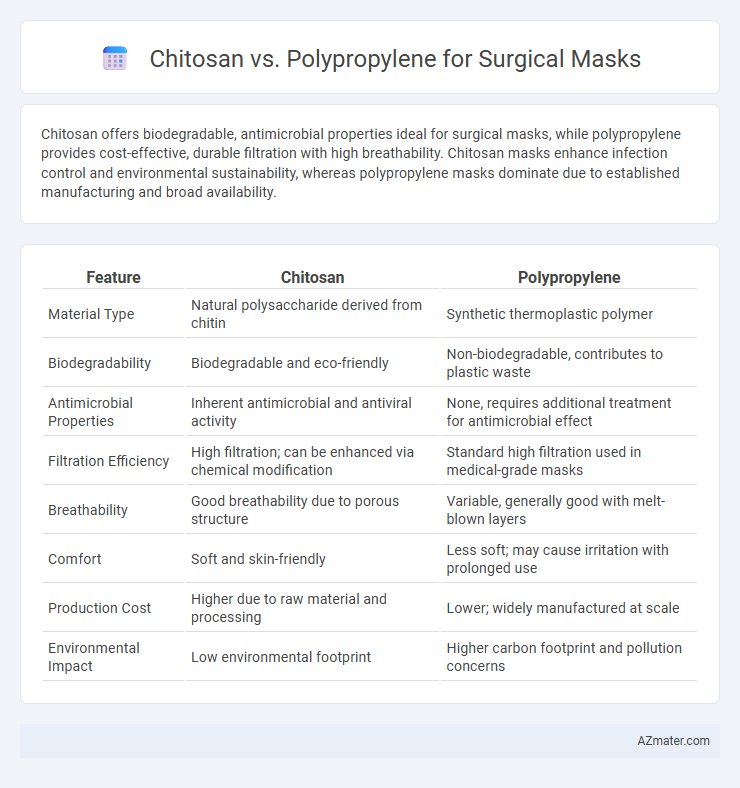Chitosan offers biodegradable, antimicrobial properties ideal for surgical masks, while polypropylene provides cost-effective, durable filtration with high breathability. Chitosan masks enhance infection control and environmental sustainability, whereas polypropylene masks dominate due to established manufacturing and broad availability.
Table of Comparison
| Feature | Chitosan | Polypropylene |
|---|---|---|
| Material Type | Natural polysaccharide derived from chitin | Synthetic thermoplastic polymer |
| Biodegradability | Biodegradable and eco-friendly | Non-biodegradable, contributes to plastic waste |
| Antimicrobial Properties | Inherent antimicrobial and antiviral activity | None, requires additional treatment for antimicrobial effect |
| Filtration Efficiency | High filtration; can be enhanced via chemical modification | Standard high filtration used in medical-grade masks |
| Breathability | Good breathability due to porous structure | Variable, generally good with melt-blown layers |
| Comfort | Soft and skin-friendly | Less soft; may cause irritation with prolonged use |
| Production Cost | Higher due to raw material and processing | Lower; widely manufactured at scale |
| Environmental Impact | Low environmental footprint | Higher carbon footprint and pollution concerns |
Introduction to Surgical Mask Materials
Surgical masks commonly utilize materials like polypropylene, a synthetic polymer valued for its filtration efficiency and breathability, and chitosan, a natural biopolymer derived from chitin known for its biodegradability and antimicrobial properties. Polypropylene's spunbond and melt-blown layers form the standard triple-layer structure that effectively blocks airborne particles. Chitosan's integration into mask materials enhances antimicrobial activity and environmental sustainability, presenting an innovative alternative to conventional polypropylene masks.
Overview of Chitosan in Medical Applications
Chitosan, a natural biopolymer derived from chitin in crustacean shells, exhibits excellent biocompatibility, biodegradability, and antimicrobial properties, making it ideal for medical applications such as wound dressings and surgical masks. Its ability to promote cell regeneration and reduce bacterial infections enhances healing and protects patients from contaminants. Compared to polypropylene, chitosan-based materials offer a sustainable and effective alternative with superior bioactivity for medical-grade mask filtration and patient safety.
Properties of Polypropylene in Surgical Masks
Polypropylene is a lightweight, non-toxic polymer widely used in surgical masks due to its excellent filtration efficiency and breathability. Its hydrophobic nature repels moisture, enhancing the mask's ability to block respiratory droplets and reducing the risk of contamination. The material's durability and resistance to chemicals and heat make polypropylene ideal for maintaining structural integrity during extended use and sterilization processes.
Filtration Efficiency: Chitosan vs Polypropylene
Chitosan exhibits superior filtration efficiency in surgical masks due to its natural antimicrobial properties and ability to capture fine particles, outperforming traditional polypropylene layers. Polypropylene, widely used in mask manufacturing, provides effective mechanical filtration but lacks intrinsic antimicrobial activity, potentially limiting its protective capability against pathogens. Combining chitosan with polypropylene enhances particle filtration and adds a biocidal function, resulting in better overall mask performance.
Biocompatibility and Safety Comparison
Chitosan exhibits superior biocompatibility due to its natural origin, biodegradability, and antimicrobial properties, making it highly suitable for surgical mask applications where skin sensitivity and infection control are critical. In contrast, polypropylene, a synthetic polymer, provides strong filtration and durability but may cause skin irritation or allergic reactions in sensitive individuals due to the absence of inherent bioactive properties. Safety evaluations demonstrate that chitosan-based masks reduce inflammatory responses and enhance wound healing potential, whereas polypropylene masks prioritize mechanical protection with limited biological interaction.
Antimicrobial Activity and Protection
Chitosan exhibits superior antimicrobial activity compared to polypropylene due to its natural biopolymer structure, which disrupts bacterial cell membranes and inhibits microbial growth, enhancing surgical mask hygiene. Polypropylene, a common synthetic material, primarily offers effective filtration and mechanical protection but lacks inherent antimicrobial properties, making masks more reliant on physical barrier function. Incorporating chitosan into masks provides dual benefits of microbial inhibition and robust protection, potentially reducing infection transmission during surgical procedures.
Environmental Impact and Biodegradability
Chitosan-based surgical masks offer significant environmental benefits due to their excellent biodegradability and natural origin, breaking down efficiently in composting conditions without releasing harmful microplastics. Polypropylene masks, commonly used in surgical settings, contribute heavily to plastic pollution as they are non-biodegradable and persist in the environment for hundreds of years, causing microplastic contamination. Choosing chitosan over polypropylene reduces ecological footprints and supports sustainable waste management in healthcare.
Breathability and Comfort for Users
Chitosan-based surgical masks exhibit superior breathability due to their natural porous structure that allows efficient airflow while maintaining filtration efficiency. Polypropylene masks, though widely used, often have denser fiber arrangements, which can compromise comfort by reducing air permeability and causing heat buildup during extended wear. Users typically find chitosan masks more comfortable for long-term use, benefiting from moisture-wicking properties and antimicrobial effects that enhance skin comfort and reduce irritation.
Cost and Manufacturing Considerations
Chitosan offers biodegradability and antimicrobial properties, but its higher raw material cost and complex extraction process make it less economical for mass production compared to polypropylene. Polypropylene dominates surgical mask manufacturing due to its low cost, ease of processing through melt-blown technology, and consistent availability as a petroleum-derived polymer. Manufacturing scalability and cost-efficiency favor polypropylene, while chitosan masks require investment in novel processing techniques, impacting overall production expenses.
Future Prospects in Mask Technology
Chitosan-based surgical masks offer superior biodegradability and antimicrobial properties compared to polypropylene, presenting a sustainable alternative for future mask technology. Innovations integrating chitosan nanofibers aim to enhance filtration efficiency while reducing environmental impact from disposable polypropylene masks. Research into combining chitosan with advanced materials promises to revolutionize protective gear by improving biocompatibility and reducing plastic waste in healthcare settings.

Infographic: Chitosan vs Polypropylene for Surgical Mask
 azmater.com
azmater.com